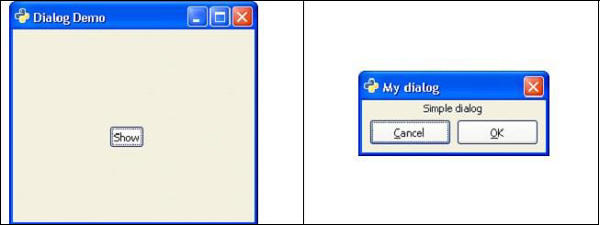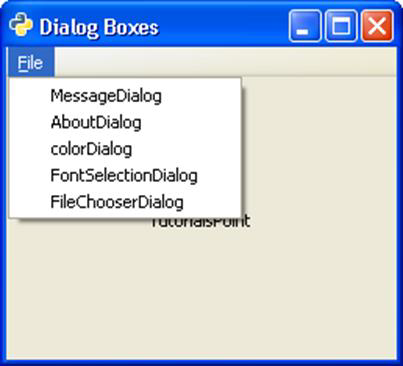
- PyGTK - Home
- PyGTK - Introduction
- PyGTK - Environment
- PyGTK - Hello World
- PyGTK - Important Classes
- PyGTK - Window Class
- PyGTK - Button Class
- PyGTK - Label CLass
- PyGTK - Entry Class
- PyGTK - Signal Handling
- PyGTK - Event Handling
- PyGTK - Containers
- PyGTK - Box Class
- PyGTK - ButtonBox Class
- PyGTK - Alignment Class
- PyGTK - EventBox Class
- PyGTK - Layout Class
- PyGTK - ComboBox Class
- PyGTK - ToggleButton Class
- PyGTK - CheckButton Class
- PyGTK - RadioButton Class
- PyGTK - MenuBar, Menu & MenuItem
- PyGTK - Toolbar Class
- PyGTK - Adjustment Class
- PyGTK - Range Class
- PyGTK - Scale Class
- PyGTK - Scrollbar Class
- PyGTK - Dialog Class
- PyGTK - MessageDialog Class
- PyGTK - AboutDialog Class
- PyGTK - Font Selection Dialog
- PyGTK - Color Selection Dialog
- PyGTK - File Chooser Dialog
- PyGTK - Notebook Class
- PyGTK - Frame Class
- PyGTK - AspectFrame Class
- PyGTK - TreeView Class
- PyGTK - Paned Class
- PyGTK - Statusbar Class
- PyGTK - ProgressBar Class
- PyGTK - Viewport Class
- PyGTK - Scrolledwindow Class
- PyGTK - Arrow Class
- PyGTK - Image Class
- PyGTK - DrawingArea Class
- PyGTK - SpinButton Class
- PyGTK - Calendar Class
- PyGTK - Clipboard Class
- PyGTK - Ruler Class
- PyGTK - Timeout
- PyGTK - Drag and Drop
PyGTK - Dialog Class
A Dialog widget is normally used as a pop-up window on top of a parent window. The objective of a Dialog is to collect some data from the user and send it to the parent window. Dialog can be modal (where it blocks the parent frame) or modeless (dialog frame can be bypassed).
The Dialog widget of PyGTK library is a window split vertically. In its top section, there is a gtk.VBox in which Label or Entry Widgets are packed. The bottom section is called action_area in which one or more buttons are placed. Two areas are separated by gtk.HSeparator.
gtk.Dialog class has the following constructor −
dlg = gtk.Dialog (Title = None, parent = None, flags = 0, buttons = None)
Where,
Title − Is the text appearing in the Title bar of the Dialog widget.
Parent − Is the reference to the toplevel window from which the dialog pops up.
Flag − Defines constants controlling operation of Dialog. The defined constants are −
| gtk.DIALOG_MODAL | If set, the dialog grabs all the keyboard events |
| gtk.DIALOG_DESTROY_WITH_PARENT | If set, the dialog is destroyed when its parent is. |
| gtk.DIALOG_NO_SEPARATOR | If set, there is no separator bar above the buttons. |
What is a Button?
A Button is a tuple object containing pairs of gtk.Button with a stock ID (or text) and its response IDs.
The response ID can be any number or one of the predefined Response ID constants −
- gtk.RESPONSE_NONE
- gtk.RESPONSE_REJECT
- gtk.RESPONSE_ACCEPT
- gtk.RESPONSE_DELETE_EVENT
- gtk.RESPONSE_OK
- gtk.RESPONSE_CANCEL
- gtk.RESPONSE_CLOSE
- gtk.RESPONSE_YES
- gtk.RESPONSE_NO
- gtk.RESPONSE_APPLY
- gtk.RESPONSE_HELP
The important methods of the gtk.Dialog class are given below −
add_button() − Adds a button with the text specified by button_text (or a stock button, if button_text is a stock ID) in action_area.
response() − Emits the "response" signal with the value specified in response_id
run() − Displays the dialog and returns the response_id when delete_event gets emitted.
set_default_response() − Sets the last widget in the dialog's action area with the specified response_id as the default widget for the dialog.
gtk.Dialog widget emits the following signals −
| Close | This is emitted when the dialog is closed. |
| Response | This is emitted when an action_area widget is activated (button "clicked"), the dialog receives a delete_event or the application calls the response() method. |
Two buttons in action_area of Dialog widget use Stock IDs gtk.STOCK.CANCEL and gtk.STOCK_OK. They are associated with response IDs gtk. RESPONSE_REJECT and gtk. RESPONSE_ACCEPT respectively. The Dialog is closed when any button is pressed. The run() methods returns corresponding response ID which may be utilized for further processing.
Following code displays a top level gtk.Window with a Button in it. When button is clicked, a Dialog appears with a label and two buttons.
Example
Observe the following code −
import gtk
class PyApp(gtk.Window):
def __init__(self):
super(PyApp, self).__init__()
self.set_title("Dialog Demo")
self.set_default_size(250, 200)
fixed = gtk.Fixed()
btn = gtk.Button("Show")
btn.connect("clicked",self.show_sialog)
fixed.put(btn,100,100)
self.add(fixed)
self.connect("destroy", gtk.main_quit)
self.show_all()
def show_sialog(self, widget, data=None):
dialog = gtk.Dialog("My dialog",
self,
gtk.DIALOG_MODAL | gtk.DIALOG_DESTROY_WITH_PARENT,
(gtk.STOCK_CANCEL, gtk.RESPONSE_REJECT,
gtk.STOCK_OK, gtk.RESPONSE_ACCEPT))
label = gtk.Label("Simple dialog")
dialog.vbox.add(label)
label.show()
res = dialog.run()
print res
dialog.destroy()
if __name__ == '__main__':
PyApp()
gtk.main()
The above code produces the following output −

Preconfigured Dialog Widgets
PyGTK API has a number of preconfigured Dialog widgets −
- MessageDialog
- AboutDialog
- ColorSelectionDialog
- FontSelectionDialog
- FileChooserDialog
In order to demonstrate the functioning of the above standard dialog in PyGTK, a menu with a menu item each invoking a dialog when clicked, is put in a gtk.Window in the following program. The Callback functions responding to activate the signal of each menu item is listed. You can also understand the explanation provided for each type of dialog widget.
Example
Observe the following code −
import gtk, pango
class PyApp(gtk.Window):
def __init__(self):
super(PyApp, self).__init__()
self.set_title("Dialog Boxes")
self.set_default_size(250, 200)
self.set_position(gtk.WIN_POS_CENTER)
mb = gtk.MenuBar()
menu1 = gtk.Menu()
file = gtk.MenuItem("_File")
file.set_submenu(menu1)
msg = gtk.MenuItem("MessageDialog")
menu1.append(msg)
abt = gtk.MenuItem("AboutDialog")
menu1.append(abt)
colo = gtk.MenuItem("colorDialog")
menu1.append(colo)
font = gtk.MenuItem("FontSelectionDialog")
menu1.append(font)
fl = gtk.MenuItem("FileChooserDialog")
menu1.append(fl)
mb.append(file)
vbox = gtk.VBox(False, 2)
vbox.pack_start(mb, False, False, 0)
self.add(vbox)
self.text = gtk.Label("TutorialsPoint")
vbox.pack_start(self.text, True, True, 0)
msg.connect("activate",self.on_msgdlg)
abt.connect("activate",self.on_abtdlg)
font.connect("activate",self.on_fntdlg)
colo.connect("activate",self.on_color)
fl.connect("activate", self.on_file)
self.connect("destroy", gtk.main_quit)
self.show_all()
def on_msgdlg(self, widget):
#MessageDialog usage code
def on_abtdlg(self, widget):
#AboutDialog usage code
def on_fntdlg(self,widget):
#FontSelectionDialog usage code
def on_color(self, widget):
#ColorChooserDialog usage cde
Def on_file(self, widget):
#FileChooserDialog usage code
if __name__ == '__main__':
PyApp()
gtk.main()
The above code will generate the following output −
